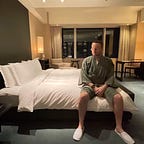Lost in Translation Filming Locations (Wardrobe Edition): 2002 Nike HTM Air Woven Rainbow (Dark Mocha)
Famed Japanese designer and influencer Hiroshi Fujiwara had a cameo appearance in the film during the nightclub scene filmed at Air in Daikanyama (which is the subject of a prior post). In that scene, Fujiwara is occupying a couch that Charlotte (Scarlett Johansson) sits on while coming to talk to Bob Harris (Bill Murray). Fujiwara has no speaking lines at the film as he and Charlotte briefly look at each other before they are both distracted by an argument brewing at the nearby bar. Nevertheless, he is easily recognizable for anyone who knows Japanese street fashion: Fujiwara is considered the ‘godfather’ of Ura-Harajuku street style fashion and is also credited as being one of the first DJs to introduce Hip-Hop music to Japan in the 1980s.
Fujiwara hails from Mie prefecture, which is just southwest of Nagoya in the heart of Honshu. He moved to Tokyo on his own at a very young age and became involved in the nascent punk scene in Japan in the late 70s and early 80s. During that time he made frequent trips to London where he fell in with the likes of fashion designer Vivienne Westwood, visual artist, designer and Sex Pistols manager Malcom McClaren, musician Boy George and ‘radical milliner’ Stephen Jones. Westwood and McClaren were also co-founders of the fashion collective SEDITIONARIES, with whom Fujiwara would become closely connected. These connections to the beating heart of London fashion and counter-culture propelled him to the forefront of the emerging Harajuku fashion scene and cemented his credentials as a top fashion influencer and trendsetter in Japan. Fujiwara credits McClaren with encouraging him to also visit New York to immerse himself in the Big Apple’s burgeoning skateboard and Hip-Hop communities.
In New York he frequented the Roxy Theatre in midtown where he took in early Hip Hop from pioneers such as Afrika Islam and Kool Lady Blue. With many of these cutting-edge records in hand, Fujiwara returned to Japan and introduced this new genre to Japan’s disaffected youth of the pre-bubble era. At this time he also decided to try his own hand at fashion designing and focused exclusively on street fashion and vintage clothing. He eventually established his flagship street fashion brand ‘GOODENOUGH’ in 1990 in Ura-Harajuku, which was partly inspired by his chance encounter with Stussy founder Shawn Stussy while visiting New York. The brand was an instant success in Japan and he went on to found or help found several of the most influential Japanese street fashion brands of the 1990s and early 2000s including ‘NOWHERE’, ‘A Bathing Ape’ and his own personal brand ‘Fragment Design’.
It was during the late 1990s and early 2000s that he also became a Nike collaborator, working with former Nike CEO Mark Parker and renowned sneaker designer Tinker Hatfield to create Nike’s HTM brand (Hiroshi, Tinker Mark) which reimagined classic Nike shoes and was responsible for creating the Nike Air Max 1, Air Trainer 1 and various Jordans. While less popular, HTM also created a line of Nike Air Wovens in 2002, which are a light trainer incorporating a colorful lattice design. One of the color options for the 2002 HTM Nike Air Wovens was ‘Dark Mocha’ which featured a lattice design of brown, orange, beige and white. It was these Dark Mocha Air Wovens that Bill Murray can clearly be seen wearing during the hospital scene of Lost in Translation and during other scenes. Because Fujiwara had a cameo in the film (and was also thanked in the film’s credits, along with his fashion brand GOODENOUGH), it is likely that Fujiwara gifted these shoes to Bill Murray or the film’s wardrobe department. The shoes are fairly rare as only about 1,500 pairs were made and they currently resale for several hundreds of dollars.
I had been scouring auction sites over the past several years to track down a pair of these though I had not had much luck as I couldn’t find a pair in the right size and/or they used and in pretty poor condition. Earlier this year, however, I came across a pair of dead stock Dark Mocha 2002 Air Wovens in exactly my size just as I began this series on Lost in Translation and quickly snatched them up from a reseller in the Netherlands. They arrived in excellent shape and even the box had little damage. Very cool to have these in hand and I look forward to wearing them next time I visit the New York Bar at the Park Hyatt.
Fragment Design at Hypebeast: https://hypebeast.com/tags/fragment-design
Hiroshi Fujiwara Instagram: https://www.instagram.com/fujiwarahiroshi/
Article on Ura-Harajuku Street Fashion: https://www.highsnobiety.com/p/hiroshi-fujiwara-history/
